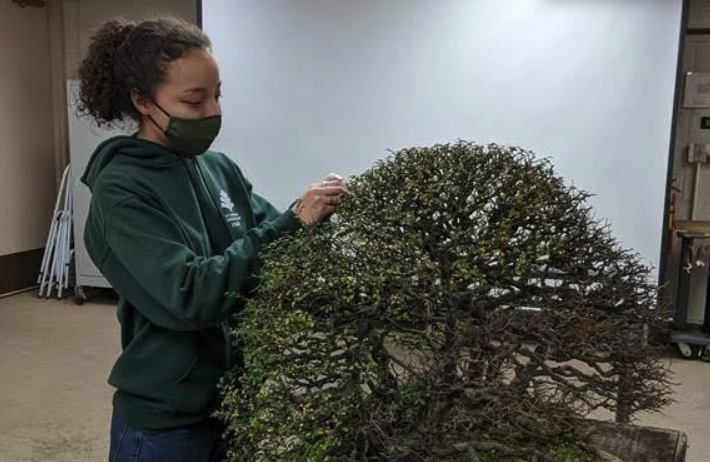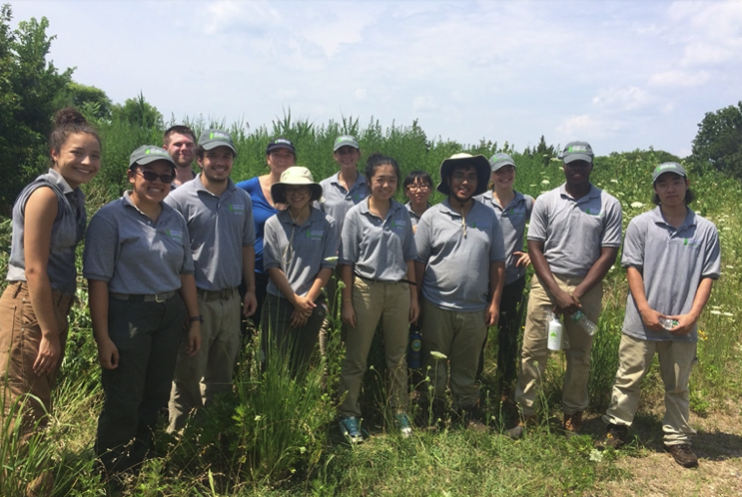Sophia Osorio cleaning leaves on a Chinese Elm Forest
“O solitary pine, how many generations of man have you known? Is it because of your great age that the passing winds sing in so clear a tone?” – Prince Ichichara, “Man’yōshū”
If you had asked me six months ago what career path I would want to pursue in the world of horticulture/arboriculture, bonsai would not have come to mind. But after spending enough pleasant time interning at the most renowned bonsai and penjing museum in the country, bonsai is now the only thing that comes to mind.
I first stumbled across the opportunity to work at the National Bonsai & Penjing Museum on a job posting wall at the New York Botanical Garden, where I was attending classes to obtain an arboriculture certificate from their School of Horticulture and Landscape Design. I was doing all the career research I could for a person like myself, with a distinct passion for arboriculture and tree care. I decided to take a chance and apply for the First Curator’s Apprenticeship, which would eventually spark my appreciation for the world of bonsai.
Like most people, I had a general familiarity with bonsai. But growing up in the hustle and bustle of New York City, I had realized that urban areas lack access to more natural landscapes. Of course, one can admire the Brooklyn Botanic Garden’s C.V. Starr Bonsai Museum or perhaps stroll through Central Park. But otherwise it can be difficult to unplug from the fast-paced, famous city that never sleeps to enjoy more reserved and peaceful environments. This is where my recognition and adoration for the Museum comes in.
Three years in a row now, Washington City Paper’s Best of D.C. poll has designated the Museum as the “Best Place to Take an Out-of-Towner,” and for good reason. Nestled in the energetic and largely concrete city of Washington, D.C., the Museum seems to slow time. Within its pavilions and tree collections, the beauty of nature is captured, condensed, perfected and displayed within the result of a centuries-old artistic tradition.
Sophia, left, and her fellow Central Park Conservancy interns gardening at Marine Park in Brooklyn, New York
Bonsai can be horticulturally defined as a tree or group of trees pruned and trained to live in a container, often for hundreds of years. The literal translation is “tray planting” or “planted in a container.” I’ve come to learn that it is truly a living art form and a small representation of the larger natural world. This realization puts into perspective the amount of hard work and effort that goes into keeping a tree just as strong and vibrant in a container as it would have been cared for in the landscape by nature.
My admiration and eagerness to learn more about bonsai has only augmented since my apprenticeship began. In trying to put the feeling of looking at a bonsai into words, I would say it is close to what one might experience if watching a renaissance painting come to life: standing in the presence and witnessing the sights of something that has been around for hundreds of years – growing, changing and living right before your eyes.
In my short tenure so far, I’ve had the privilege of working on trees donated by prominent figures in bonsai history, like the Japanese white pine that survived the bombing of Hiroshima, donated by bonsai master Masaru Yamaki. The notion that a tree that has experienced so much history can still be alive and flourish with the help of many passionate staff members here at the Museum has made the art of bonsai one of the most inspiring practices I’ve ever been part of.
From daily tasks, like watering every tree in the collections to the technique of selecting and pruning of branches to reshape a tree’s structure or entirely repotting a tree, I feel as though I have merely scratched the surface of the hard work and dedication needed to keep a bonsai thriving. This is truly an experience I want to share, expand on and practice more of for many years to come.
With enthusiasm,
Sophia Osorio
First Curator’s Apprentice
National Bonsai & Penjing Museum
U.S. National Arboretum







